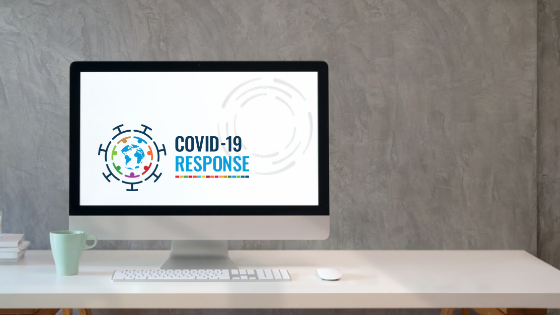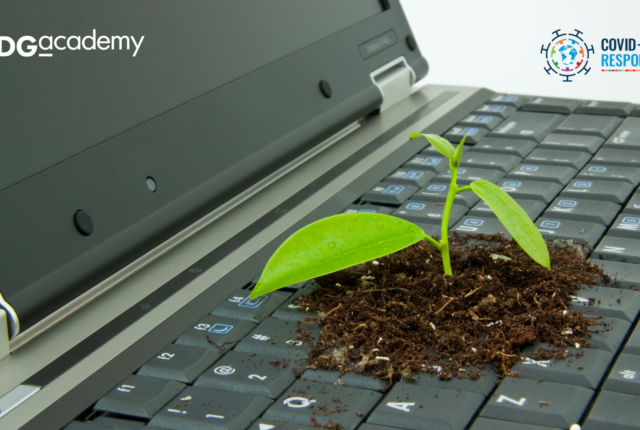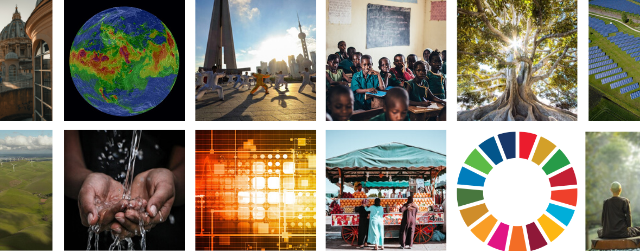A message from our Director
Dear friends,
As COVID-19 tests us on all fronts, all of us at the SDG Academy send our learners around the world our very best wishes, and the hope that you are home, safe, and healthy. The pandemic reminds us once again that we are all part of a global community, and that the integrated nature of the 2030 Agenda matters more than ever. We are seeing an unprecedented health challenge directed at people around the world; strategies to combat it have threatened global prosperity, as economies worldwide go into weeks-long lockdowns; and during these trying times, we see immediately the benefits of this temporary retreat of humanity on the planet. As members of the SDG Academy community, you know that these interdependencies matter, and that a sustainable world would mean not having to make such stark choices of one over the other.
We are confident that humanity’s collective spirit of compassion and inventiveness will triumph over this pandemic; we are committed to presenting the knowledge and tools that can make sure that we build a more sustainable world during and in its aftermath.
Best wishes,
Chandrika Bahadur
Director, SDG Academy
At the SDG Academy, we are more dedicated than ever to helping you understand the context of the crisis, enabling the achievement of the SDGs through remote learning, and empowering educators around the world to teach online.
Current contributions
- The SDG Academy is proud to participate in the edX Remote Access Program and edX Open Campus. If your institution is distributing edX voucher codes through these programs, you can use the code to upgrade to the Verified Track of any SDG Academy course from now through June 30, 2020. If you are a university student or faculty member, ask your institution about joining the edX Open Campus.
- We have joined the UNESCO Global Education Coalition for COVID-19. Find a link to our SDG Academy Library in the Coalition’s list of Distance Learning Solutions.
- Our popular online course on Global Public Health is currently running self-paced on edX. Videos from the course are also available as stand-alone resources in the SDG Academy Library.
- Also in the SDG Academy Library, we have created an “Understanding COVID-19” playlist containing videos to help you understand the current pandemic in the wider context of global public health.
- In March, the SDG Academy held a webinar to introduce our courses and video library as free, high-quality resources for online teaching, and propose ideas on how to integrate them into a lesson, to a broad audience of educators from around the world. Click here to learn more about how you can use SDG Academy educational resources for remote teaching and learning, and watch a recording of that webinar.
- On March 30, the SDG Academy and the Sustainable Development Solutions Network co-hosted a virtual conference on the COVID-19 pandemic and its implications for the global economy. Read a summary of the conference and watch a recording.
- On April 22, the SDG Academy hosted a panel discussion on education for sustainable development with speakers from UNESCO, the Ban Ki-moon Centre for Global Citizens, and Teachers College, Columbia University, as part of SDSN’s 24-hour Earth Day webinar, “Happiness & Sustainability Around the Earth.” Watch a recording of the session.
- On April 27, the SDG Academy and the Sustainable Development Solutions Network hosted a second virtual conference on the implications of COVID-19 for public health and the SDGs. Click here to watch the recording.
- On May 26, we hosted Dr. Daniel Kaufmann, Chief Advisor and former President & CEO of the Natural Resource Governance Institute, for a Q&A webinar on natural resource governance in the COVID crisis era, offered alongside our course on Natural Resources for Sustainable Development.
- On June 4, Prof. Hirokazu Yoshikawa, lead faculty of our course The Best Start in Life, answered learners’ questions about the current state of early childhood development in the context of COVID. Watch the recorded Q&A.
- On June 19, we co-hosted a virtual conference with Prof. Jeffrey Sachs, author of the new book The Ages of Globalization, where he discussed 70,000 of globalization and how we can meet the challenges and opportunities of our time. Watch the recording.
Resources for moving your lessons online
Since universities began moving their operations online, outlets from across the educational sector have been rushing to provide best practices, tips, and tools for adjusting to remote teaching. There is a lot of information out there, and not all of it will be relevant to you.
We recognize that each institution, and even each classroom, is operating with its own context and considerations, and that there is no one-size-fits-all solution. However, we hope that the following “Essential Questions” will help you think through how best to move your lessons to an online format.
Essential Questions
- What tools and resources does your institution already offer?
- Should your lessons be synchronous, asynchronous, or a mix of both, depending on the content? What is the difference?
- How can you keep your students engaged?
- What experiences cannot be moved online (labs, field experiences, etc.), and what virtual alternatives can you assign instead?
- Should you adapt existing lesson plans to the virtual environment, create new lesson plans, or some combination of the two?
- What adjustments must you make for students with physical or cognitive disabilities?
- How can you best serve students amidst all the changes and stress?
Other points to consider:
- This is a transition for you as well as for your students.
- Not all of your students will be in the same time zone.
- Some students may be missing virtual lessons due to accessibility issues or other challenges. Reach out to them if you can.
- Record live sessions for students who can’t attend.
- Think about projects that students can complete in their homes or within their communities that align with what they are learning.
Additional resources for easing the transition
- [Text] “Values-Centered Instructional Planning,” Inside Higher Ed
In this article, Robin DeRosa, Director of Interdisciplinary Studies at Plymouth State University, explains how universities must adopt a new pedagogical framework, not only new tools, as they prepare to teach remotely in the next semester and beyond.
Launched by UNESCO, the Coalition is a multi-sector partnership to provide appropriate distance education for all learners. Click here to browse their list of educational applications, platforms, and resources.
This crowdsourced list has remote teaching information from many universities and guides for moving courses online. It was started by Daniel Stanford, Director of Faculty Development & Technology Innovation at DePaul University’s Center for Teaching and Learning.
- [Website] “Global Teaching and Learning Resources,” UC Davis
This list from our partners at UC Davis links to online teaching resources for faculty and online learning resources for students, with particular mention of how students can engage with and take action on global issues through the SDGs. (Please note that some content is specific to the UC Davis community, but much is relevant for a wider audience.)
- [Text] “Best Practices: Online Pedagogy,” Harvard University
This page provides general advice, a variety of course types, and additional tips on student engagement broken up according to common teaching styles (lecture, case, small group discussion, and hands-on).
- [Text] “Five tips for moving teaching online as COVID-19 takes hold,” Nature
This article offers expert advice on how to embrace the digital classroom.
- [Podcast] “Coronavirus Has Led to a Rush of Online Teaching. Here’s Some Advice for Newly Remote Instructors,” EdSurge
In this 25-minute podcast, Bonni Stachowiak, Dean of Teaching and Learning at Vanguard University of Southern California, gives a quick primer on what instructors need to know when converting their in-person classroom to a virtual classroom.
This article explores the pros and cons of synchronous (or “live”) and asynchronous (or “on-demand”) online teaching.
This webinar from Kaltura, the company that hosts our SDG Academy Library, presents some best practices for using video as part of your institution’s transition to a virtual environment, including lessons, assignments, and other campus operations. (Please note that this webinar speaks specifically to the United States academic context and may be less useful to an international audience.) If your institution currently uses Kaltura to manage its video resources, you may want to check out Kaltura’s information on how it is supporting customers during the crisis.
This blog post by DePaul University’s Dan Stanford advises educators to rethink high-bandwidth applications such as video conferencing and instead consider different technologies that may be more useful and reliable in a variety of contexts.
- [Text] “How to Reconnect With Students and Strengthen Your Remote Course,” The Chronicle of Higher Education
Chronicle journalist Beth McMurtrie shares insights from three professors on how to provide students with remote support and creative engagement opportunities.


